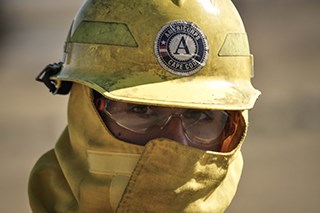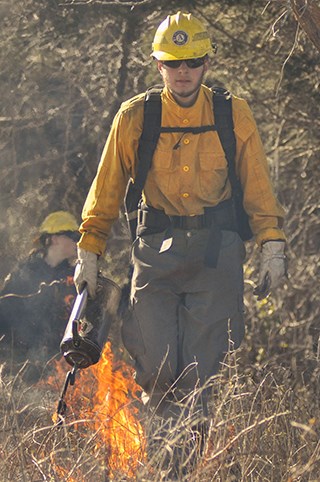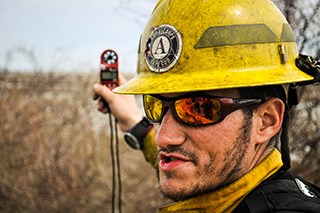
NPS/Hunter Moore Caring for the park, one burned acre at a time!Located on the outer portion of the Cape, the Cape Cod National Seashore is made up of over 43,500 acres of shoreline, salt marshes, kettle ponds, dunes, heathlands and upland forests. Under the management and discretion of the Park Superintendent, the Fire Management Office has been given the responsibility to care for select areas of upland forest within the seashore. Several planning documents assist in this, including a Fire Management Plan. The plan focuses on:

NPS/Hunter Moore SafetySafety starts with good leaderships and well trained people. The park’s fire management team is lead by a fire management officer, an engine supervisor and a program management assistant. In addition, summer and winter fire crews are hired to implement projects outlined in the Fire Management Plan. Each crew consists of up to six individuals employed as Forestry Technicians.Fire crewmembers complete wildland firefighting and fire behavior training. Every year after, crewmembers complete a one-day fire safety refresher and a fitness test. The “work capacity test” requires a person to walk three miles in 45-minutes or less carrying a 45-pound pack. Additional training is provided for operation and maintenance of chainsaws, engines, and pumps. 
NPS/Hunter Moore Resource ManagementFor thousands of years, wildfires have been a key part of the upland ecosystems on Cape Cod. Decades of fire suppression have altered historic fire cycles and allowed fuels to accumulate. This has increased the chance of wildfires which could threaten land and structures within the park.The Fire Management Plan, part of the Resource Management Plan, allows for mechanical treatments (chainsaw or brush cutter) and prescribed burns within the park. These treatments are utilized to reduce fuels, protect structures and restore habitat. During the winter, the fire crew conducts “cut, pile and burn” projects to remove vegetation from around park structures. These projects create defensible space, protecting structures from fire and storms. Fire suppression over the years has led to the decline and disappearance of fire-dependent communities such as grasslands and heathlands. In 2008, the fire crew began the restoration of 270 acres of heathlands at Marconi Site in Wellfleet. Dividing the project into smaller units, the fire crew use chainsaws to remove scrub oak and reduce the number of pitch pine trees. After a unit has been treated, a prescribed fire can be conducted. The Use of FireThe park utilizes prescribed fire as a management tool to accomplish a variety of goals. Prescribed fires simulate the positive effects of wildfire under safe conditions. The benefits of burning include: removal of excess vegetation; stimulation of plant growth and regeneration; maintenance of wildlife habitat; reduction of fuels around the park in order to decrease the chances of a catastrophic wildfire; and provide training opportunities for wildland firefighters.Through cooperative agreements, the fire crew also assists local town, state and federal agencies as well as local conservation agencies with prescribed fire needs. 
NPS/Hunter Moore Researching the Effects of FireFire management continues to evolve with practice, research and evaluation. In 1986, the Fire Management Program, in cooperation with the University of Massachusetts at Amherst began an important research project. The project documented the effectiveness of varying the season and frequency of burning or cutting on forest composition, fuel loading and fire behavior. Sixty 0.1-acre plots were established in the Lombard-Paradise Hollow Research Area in South Truro. With over 25 years of data collected, the research conducted has set the stage for large scale fuel treatments conducted throughout the park.The crew has also worked in conjunction with park scientists to better understand the effects of fire on Phragmites australis, an invasive plant, in Hatches Harbor in Provincetown. 
NPS/Kekoa Rosehill Lending a Helping HandDuring times of high fire activity and other natural disasters, the Cape Cod National Seashore Fire Crew is mobilized to provide additional support. Crews from the Seashore have been sent to fight wildfires in such places as California, Idaho, Alaska, and Canada. |
Last updated: February 7, 2018
